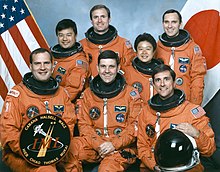 Spacelab Module LM1 in Columbia's payload bay, serving as the International Microgravity Laboratory | |
| Names | Space Transportation System-65 |
|---|---|
| Mission type | Microgravity research |
| Operator | NASA |
| COSPAR ID | 1994-039A |
| SATCAT no. | 23173 |
| Mission duration | 14 days, 17 hours, 55 minutes |
| Distance travelled | 9,886,200 kilometers (6,143,000 mi) |
| Orbits completed | 235 |
| Spacecraft properties | |
| Spacecraft | Space Shuttle Columbia |
| Payload mass | 10,811 kilograms (23,834 lb) |
| Crew | |
| Crew size | 7 |
| Members | |
| Start of mission | |
| Launch date | 8 July 1994, 16:43:01 UTC |
| Launch site | Kennedy, LC-39A |
| End of mission | |
| Landing date | 23 July 1994, 10:38:01 UTC |
| Landing site | Kennedy, SLF Runway 33 |
| Orbital parameters | |
| Reference system | Geocentric |
| Regime | Low Earth |
| Perigee altitude | 300 kilometres (190 mi) |
| Apogee altitude | 304 kilometres (189 mi) |
| Inclination | 28.45 degrees |
| Period | 90.5 minutes |

 Left to right - Seated: Hieb, Cabana, Thomas; Standing: Chiao, Halsell, Naito-Mukai, Walz | |
STS-65 was a Space Shuttle program mission of Columbia launched from Kennedy Space Center, Florida, 8 July 1994. The flight carried a crew of 7 and was commanded by Robert D. Cabana who would go on later to lead the Kennedy Space Center. STS-65 was an international science mission that carried the International Microgravity Laboratory (IML-2) on an 15-day mission.[1] Columbia returned to the Kennedy Space Center on 23 July 1994.
- ^ "STS-65 Press Kit". NASA. Archived from the original on 29 June 2011. Retrieved 22 August 2010.